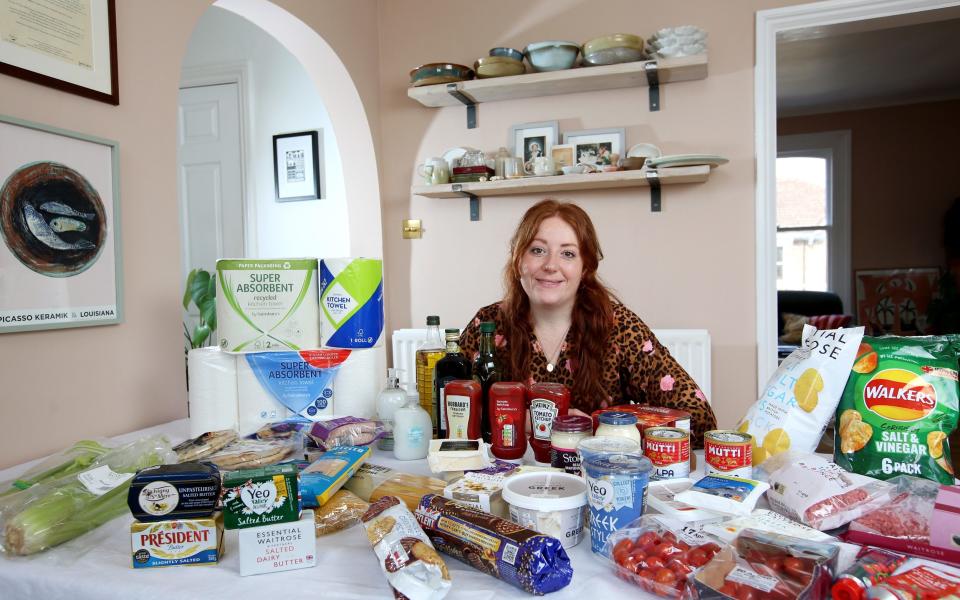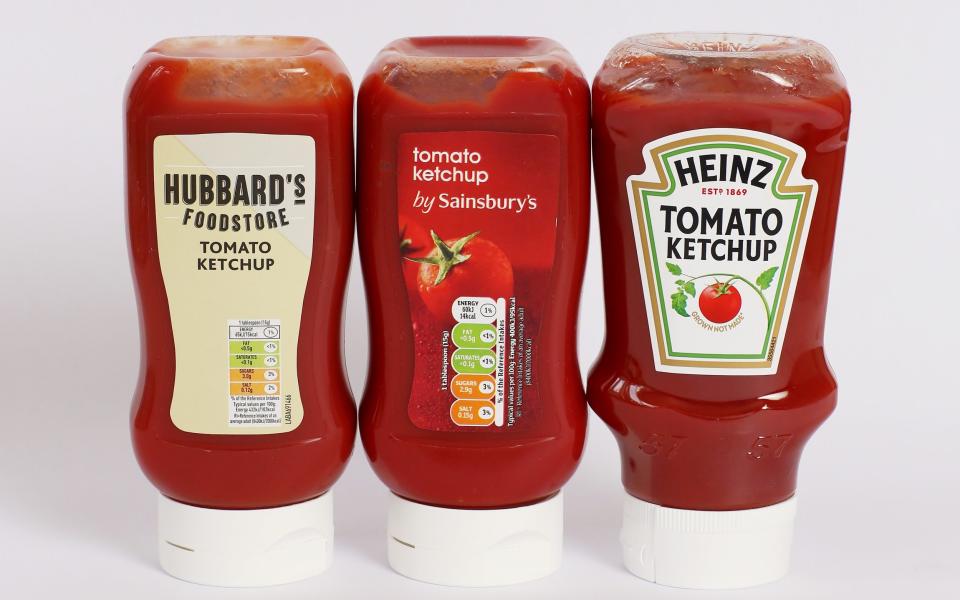The cost-saving supermarket switches that taste just as good

I am standing in Waitrose, clutching two bunches of celery. One, marked “essential” is 70p. The other is the premium stuff, labelled “Cooks’ celery”. You’d be hard pressed to discern any difference between them. They look identical, they’re roughly the same weight and are both grown in Spain. But the “Cooks’ celery” (with its chic font that seems to say “this is going to make your bolognese so much tastier than that other celery ever could”) inexplicably costs £1.70, a full pound more than its rival.
As the cost of living digs ever deeper, this extra pound – alongside the others charged elsewhere in the grocery aisles – could add up to something significant. According to recent estimates, the average middle-class family will lose £4,600 over the next year in rising prices and taxes. Inflation has soared to a 30-year high: the price of bread increased by 2.3 per cent in March, and is now 5.5 per cent more expensive than it was a year ago, according to the Office for National Statistics. Food and non-alcoholic drinks saw inflation hit 5.1 per cent – its highest level since September 2011. No wonder economists are now warning the UK could slip into recession in the second and third quarters of the year.
Therefore, to examine the branding in our supermarket aisles – and perhaps look beyond it – is becoming more crucial than ever. It’s led Martin Lewis, founder of MoneySavingExpert.com, to encourage Brits to take what he calls the Downshift Challenge. He argues that consumers could save 30 per cent of their weekly shop every year “without noticing the difference”, if we simply opted for the slightly cheaper option when filling our trolleys. For a family that spends £100 on their weekly shop, Lewis estimates a 30 per cent cut would mean you’d save £1,500 over the course of 12 months.

Supermarket branding is among the most powerful in the business. Tesco Finest, Taste the Difference, Specially Selected. You’ll immediately see an image of “luxe” packaging, perhaps a little Union flag to denote impressive locality… the word “artisan” (so overused it has been rendered almost meaningless) may start to float through your thoughts.
We gauge a lot – possibly too much – about the quality of our food and household products from the way they are marketed. When faced with a so-called luxury chocolate pudding from, say, the Tesco premium collection and an almost identical one from their budget range, it’s hard not to feel the “luxury” pud is going to be the better, tastier option. What’s actually in it? It almost doesn’t matter. Our consumer brains have been told it’s a premium product. The ingredients might be practically identical, but the packaging (and, therefore, the price) tell a different story.
Supermarkets, says Lewis, tend to be split into four main brand levels: premium, branded, own brand and value. The key? Knowing what to fork out for and where to make savings, when to stick to your guns and get that branded bottle of sweet chilli sauce, and when to go own-brand.
So, this week, I decided to conduct my own experiment. I compared products across Lewis’s four categories in Aldi, Sainsbury’s and Waitrose.
Branded, I discovered, doesn’t always mean best.
In Sainsbury’s, where the budget range was launched in 2019 under the name Hubbard’s Foodstore, and cleverly marketed to look more vintage “store cupboard”, value products were better than the more expensive options in a couple of notable areas. Hubbard’s spaghetti – at 40p for 1kg against Sainsbury’s mid-range which goes for £1.30, or De Cecco at £2 – is bitier and has more flavour than the mid-range, and is a perfectly good alternative to the expensive stuff.
Ben Ebbrell, chef and co-founder of YouTube cooking channel and food community Sorted Food, agrees cheap own-brand pasta is a perfectly good alternative to the expensive stuff. “I don’t think you can go wrong with using basic supermarket spaghetti in most dishes, and it saves a lot of money,” he says.
“We recently tested a Sainsbury’s basics pasta (55p per 500g) versus a premium brand ‘Pastificio dei Campi’ (£5.99 per 500g). Despite the latter being way more expensive, our blindfolded testers could not tell the difference,” says Ebrell. “They both have the same basic ingredient – durum wheat, but it is generally how the pasta is cut that makes the difference in price and thus changes its texture, something that is not usually that important for midweek pasta dishes.”
On the ketchup: I’m normally a Heinz devotee, so am as surprised as anyone to report that Hubbard’s ketchup is also worth a try, at 44p for a 460g bottle against £2.30 for a bottle of Heinz. It has a more vinegary, pickled flavour than Heinz, but it’s a decent stand-in. I wouldn’t bother with the mid-range Sainsbury’s own brand though, which is far too sweet.

The tinned, tubed and bottled tomato section has become a minefield. In Sainsbury’s, one tin of Mutti chopped tomatoes will set you back £1.20. It’s a lot for 400g of tomato pulp, but you’re paying for flavour and a low water content, the likes of which you simply won’t find in a pack of own-brand chopped toms (four for £1.60). The cheaper stuff has to be cooked for longer to get an intensity of flavour. But still, £1.20 is a lot for a tin of toms.
If it’s tomato purée you’re after, though, it turns out it’s fine to go for the cheap stuff. There is very little difference in flavour between tubes of tomato paste. If anything the £1.30 Taste the Difference paste is too sweet compared with the 40p basic purée.
Fruit and veg is a trickier area. Often with fresh ingredients, price equals quality, but look a little closer and you’ll find (as with the Waitrose celery) that isn’t always the case. For instance, 250g of Sainsbury’s Taste the Difference pomodorino baby plum tomatoes will cost you £2. For half that price, you could get a 325g bag of “Sainsbury’s baby plum tomatoes”. They look and taste identical, the only discernible difference being the packaging and the name, one of which sounds like they might have actually come from Italy (they haven’t, they’re both from Morocco).
The cheese aisle at Waitrose is a real head scratcher. There are about five different kinds of feta and no discernible difference between any of them. With yoghurt, though, you might as well get the fancy stuff at Waitrose. A 450g pot of Yeo Valley Greek yoghurt is £1.70, compared with the Waitrose No 1 strained Greek yoghurt which is £1.90 for 500g. The latter is richer, and slightly better value.

If there’s an offer on a higher brand making it cheaper than downshifting, Lewis suggests sticking with the higher brand. In Sainsbury’s, I spotted a 500ml bottle of Bayliss and Harding hand soap reduced from £2 to £1.50. This compared with a fairly basic bottle of Sainsbury’s own-brand stuff which was 85p for just 250ml, and not nearly as nice.
In Aldi, meanwhile, it’s worth going budget on dairy and pork products. Its 400g extra mature Cheddar at £1.99 is nicer, in my humble opinion, than the 220g block of premium stuff for the same price.
We tend to assume price equals quality when it comes to meat, but at Waitrose, a pack of beef mince from the essentials range costs £1.25 less than its more expensive “Aberdeen Angus” offering. The fat content is the same, and while the meat might be slightly nicer quality in the £3.75 pack, I’m not convinced there’s such a huge difference.
When it comes to olive oil, though, you might want to ponder your options. A 750ml bottle of Aldi’s extra virgin olive oil is £2.29. For 56p more you could get 250ml more of a lower quality oil. The extra virgin tastes a hell of a lot nicer, and with such little price difference you may want to treat yourself to it. Just don’t bother with its £5.99 “specially selected” extra virgin olive oil. In reality, you’re just paying for the glass bottle.
Finally, if it’s budget treats you’re after, Waitrose does a good line. Its own-brand milk chocolate digestives are 90p, compared with a pack of McVities which will set you back £2.30. And its six-pack of salt and vinegar crisps is just 90p compared with £1.70 for a pack of Walker’s. They’re just as nice and, helpfully, contain slightly fewer calories.
In fact, at the end of this experiment, I find the only branded items I’m loyal to are Heinz beans and Marmite. Luckily, I’m a light scraping of Marmite on my toast sort of girl, so a pot of the good stuff will last me six months. With apologies to Martin Lewis, I simply can’t get behind a generic “yeast extract”.

 Yahoo News
Yahoo News 